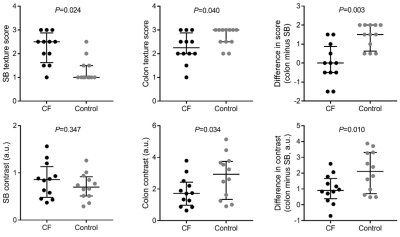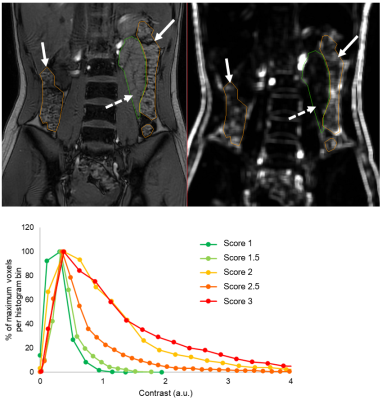Neele S Dellschaft1,2, Caroline Hoad1,2, Christabella Ng2,3, Luca Marciani2,4, Robin Spiller2,4, Alan Smyth2,3, Giles Major2,4, and Penny Gowland1,2
1Sir Peter Mansfield Imaging Centre, University of Nottingham, Nottingham, United Kingdom, 2Nottingham NIHR Biomedical Research Centre, University of Nottingham, Nottingham, United Kingdom, 3Division of Child Health, Obstetrics and Gynaecology, University of Nottingham, Nottingham, United Kingdom, 4Nottingham Digestive Diseases Centre, University of Nottingham, Nottingham, United Kingdom
1Sir Peter Mansfield Imaging Centre, University of Nottingham, Nottingham, United Kingdom, 2Nottingham NIHR Biomedical Research Centre, University of Nottingham, Nottingham, United Kingdom, 3Division of Child Health, Obstetrics and Gynaecology, University of Nottingham, Nottingham, United Kingdom, 4Nottingham Digestive Diseases Centre, University of Nottingham, Nottingham, United Kingdom
Compared to
healthy controls, the texture of the contents of the small bowel was abnormal
in people with CF, as observed both by Haralick texture analysis and subjective
analysis of T1-weighted images. These findings suggest small bowel bacterial overgrowth.

Fig 4: Assessment of small bowel and colon texture both subjectively
(top) and by Haralick contrast (bottom; median and IQR, P-values for Wilcoxon tests).
When assessing small bowel and colon texture as well as their
difference subjectively, all were distinctly altered in people with CF.
Whilst we could not detect a difference in small bowel
texture using the Haralick analysis, texture in the colon was lower in people
with CF than in healthy controls. The difference between texture in colon and
in small bowel were less distinct from each other in people with CF.

Fig 3: Small bowel and colon
texture. Top, a coronal T1-weighted image was calculated into a Haralick
contrast map. Example shown is a healthy control participant with typical
textures in both small bowel (dashed arrow) and colon (solid arrows). Bottom, example
curves (histograms) of a small bowel ROI of the Haralick contrast map. T1-weighted
images were scored between 1 (normal, smooth) and 3 (mottled, see also Fig 3).
The small bowel ROI of the resulting Haralick contrast map was then analysed, illustrating
how the higher the score for heterogeneity, the wider the histogram tended to
be
